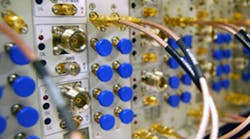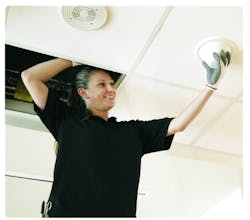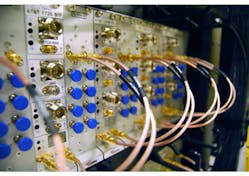This file type includes high-resolution graphics and schematics when applicable.
Wireless-communications technology keeps people and things connected, unless, of course, they’re without access to a wireless network. Fortunately, as devices and components for wireless systems improve in terms of performance versus power consumed, antennas are improving, too, enabling wireless access in what were once deadspots, such as within buildings. By using small cells and distributed antenna systems (DAS), wireless networks continue to enhance indoor and outdoor coverage, supporting quality voice, data, and video communications.
Internet access has become essential for most wireless networks, as users grow accustomed to mobile access in any location, whether in a car, office, or shopping center. While larger cell sites and cellular antenna towers can deliver wireless reception and transmission across healthy distances, deadspots often exist in clusters of buildings or within individual buildings if not augmented with small cells and DAS setups. Service providers such as AT&T, Sprint, T-Mobile, and Verizon often point to DAS technology as a key ingredient to successful wireless coverage and performance within buildings, even with ever-growing pool of wireless customers and activity.
What’s a DAS?
A DAS consists of multiple antennas adjusted to provide full coverage across a building or specific coverage area. In addition to delivering uninterrupted wireless coverage, a DAS can boost network capacity when a need arises, such as during a recital in a concert hall or a sporting event in a stadium, when the number of wireless users increases dramatically for a relatively small area. To augment coverage, service providers often have mobile networks or what some have termed a “DAS on wheels,” which is a wireless system with multiple antennas and amplifiers that can be transported and operated within a truck or other vehicle.
Typically, a DAS or small cellular system comes as a complete system solution, and is relatively easy to install near a power source in an area that requires additional wireless coverage. For example, Accu-Tech developed a series of small cells for increasing the coverage of in-building wireless (IBW) systems, drawing upon the components and technologies from a large number of suppliers/partners, including Amphenol, Andrew Corp., Belden, MP Antenna, and Times Microwave Systems.
One supplier, Commscope, crafted a series of DAS-based solutions that offer enhanced wireless coverage while maintaining high levels of network security. The firm’s DAS products employ a multifrequency-band approach for maximum coverage and minimal interference with existing wireless infrastructure equipment.
The DAS antennas are designed for installation in difficult-to-cover areas, such as tall office buildings, shopping malls, and parking garages. They handle various portions of the frequency range from 1710 to 2700 MHz. Commscope combined directional and omnidirectional antennas that can be adjusted in 2- and 5-deg. increments for optimum coverage, and linked the antennas by means of wireless technology and radio-over-fiber (RoF) technology to take advantage of the enormous bandwidth of optical cables. The end result is a wide range of solutions for some of the most challenging locations, such as tall buildings.
Small Cells Plus DAS
In terms of providing wireless coverage for challenging areas, DAS Simplified has installed a number of small cells and DAS solutions for known locations, including the Auburn Medical Center (Auburn, Ga.) and the Max Planck Florida Institute for Neuroscience (Jupiter, Fla.). The Auburn Medical Center is a campus consisting of three buildings on a total area of 350,000 square feet. Facility managers were concerned with wireless “deadspots” on the campus, especially in terms of public safety, and realized that they needed additional in-building coverage, not only for commercial cellular communications users but for public safety responders in case of emergencies.
The small cells and DAS installed by DAS Simplified on the campus (Fig. 1) featured directional and omnidirectional antennas in unobtrusive ceiling-mount housings, and dramatically improved the wireless service within the campus and its three buildings. The company optimizes and maintains the performance of the DAS installation per regulatory guidelines.
To keep the installation with guidelines, the company uses portable commercial spectrum analyzers (Site Master analyzers from Anritsu Co.) and other portable test gear to ensure optimum performance for installed systems. This includes a minimum return loss of 14 dB and full cellular/wireless coverage throughout a facility. DAS installers such as DAS Simplified typically create a coverage map of a facility or installation area to show the different wireless-signal power levels throughout the covered area.
An important part of any DAS or small-cell system is the headend assembly (Fig. 2), which is the point of interface between the DAS and the existing wireless or wired network. The headend assembly must be properly connected to wireless carrier networks as well as to public safety systems, with power levels for the installed DAS and small-cell systems set according to carrier specifications. Such installations and testing have been greatly simplified by the increasing availability of high-quality portable RF/microwave test equipment from a number of leading suppliers, including Anritsu, Keysight Technologies, Rohde & Schwarz, and Tektronix.
System-level computer-aided-engineering (CAE) simulation software also serves as a valuable tool for many DAS system integrators. Prior to an installation, many DAS system integrators will use RF/microwave-system simulation software to model the propagation behavior of a site, to anticipate trouble areas and predict the types of antennas and performance levels that will be needed for optimum wireless coverage.
The DAS examples detailed earlier refer to in-building coverage as a main application for small cells and DAS technology. It is important to note, however, that DAS technology and small cells are often used for outdoor installations. These include public gathering places (stadiums) and in any area where tall buildings may serve as obstructions or “barriers,” thus preventing the penetration of wireless signals from an existing cellular communications network.



